2013 Hyundai Sonata Hybrid brake
[x] Cancel search: brakePage 408 of 425
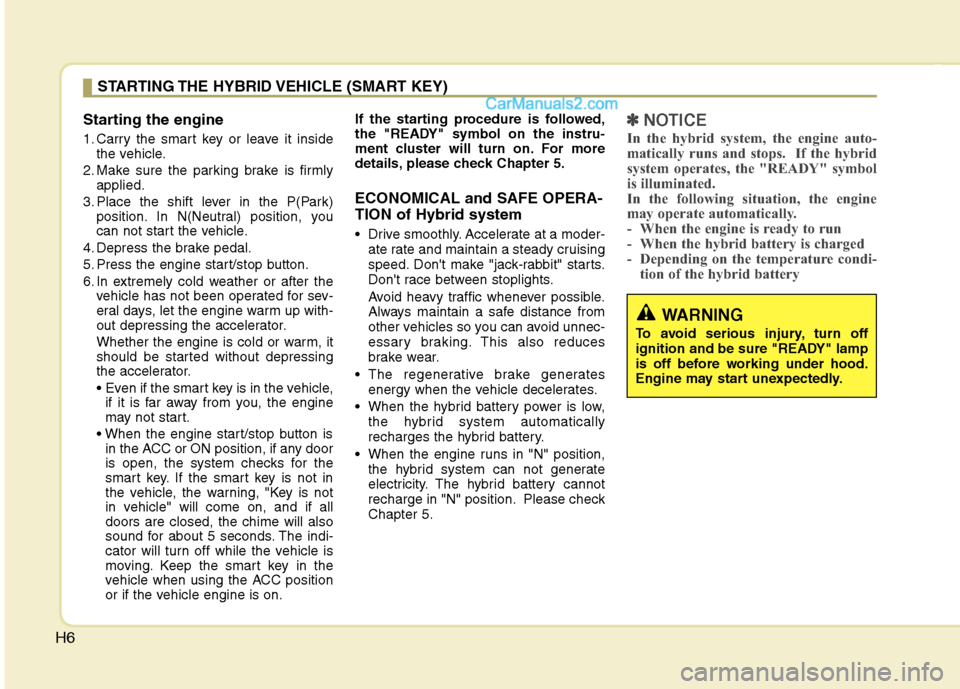
H6
Starting the engine
1. Carry the smart key or leave it inside
the vehicle.
2. Make sure the parking brake is firmly
applied.
3. Place the shift lever in the P(Park)
position. In N(Neutral) position, you
can not start the vehicle.
4. Depress the brake pedal.
5. Press the engine start/stop button.
6. In extremely cold weather or after the
vehicle has not been operated for sev-
eral days, let the engine warm up with-
out depressing the accelerator.
Whether the engine is cold or warm, it
should be started without depressing
the accelerator.
if it is far away from you, the engine
may not start.
in the ACC or ON position, if any door
is open, the system checks for the
smart key. If the smart key is not in
the vehicle, the warning, "Key is not
in vehicle" will come on, and if all
doors are closed, the chime will also
sound for about 5 seconds. The indi-
cator will turn off while the vehicle is
moving. Keep the smart key in the
vehicle when using the ACC position
or if the vehicle engine is on.If the starting procedure is followed,
the "READY" symbol on the instru-
ment cluster will turn on. For more
details, please check Chapter 5.
ECONOMICAL and SAFE OPERA-
TION of Hybrid system
Drive smoothly. Accelerate at a moder-
ate rate and maintain a steady cruising
speed. Don't make "jack-rabbit" starts.
Don't race between stoplights.
Avoid heavy traffic whenever possible.
Always maintain a safe distance from
other vehicles so you can avoid unnec-
essary braking. This also reduces
brake wear.
The regenerative brake generates
energy when the vehicle decelerates.
When the hybrid battery power is low,
the hybrid system automatically
recharges the hybrid battery.
When the engine runs in "N" position,
the hybrid system can not generate
electricity. The hybrid battery cannot
recharge in "N" position. Please check
Chapter 5.
✽ ✽
NOTICE
In the hybrid system, the engine auto-
matically runs and stops. If the hybrid
system operates, the "READY" symbol
is illuminated.
In the following situation, the engine
may operate automatically.
- When the engine is ready to run
- When the hybrid battery is charged
- Depending on the temperature condi-
tion of the hybrid battery
STARTING THE HYBRID VEHICLE (SMART KEY)
WARNING
To avoid serious injury, turn off
ignition and be sure "READY" lamp
is off before working under hood.
Engine may start unexpectedly.
Page 409 of 425
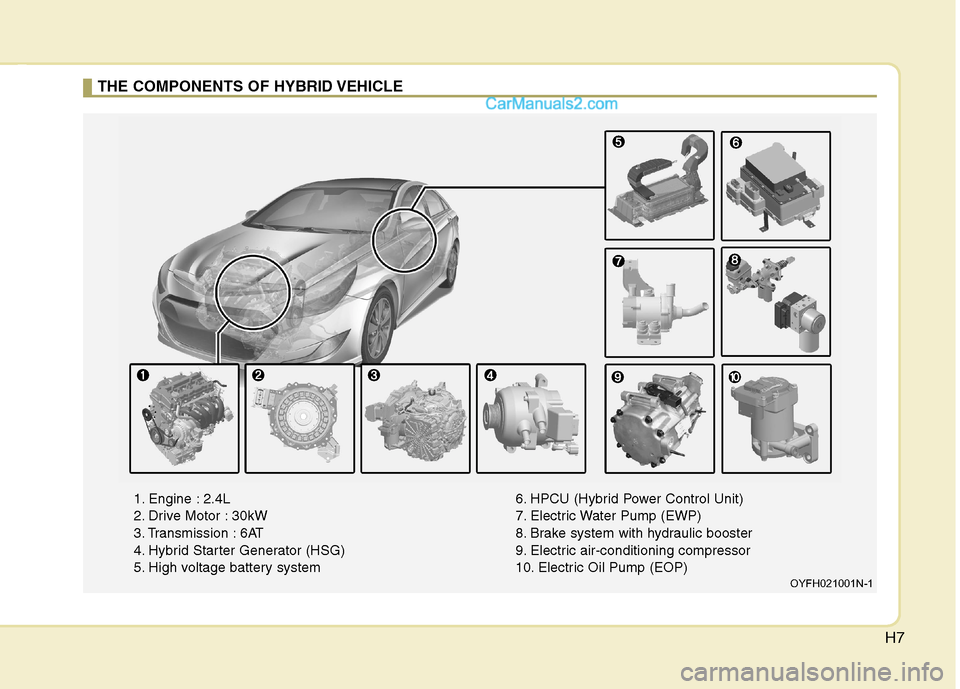
H7
THE COMPONENTS OF HYBRID VEHICLE
OYFH021001N-1
1. Engine : 2.4L
2. Drive Motor : 30kW
3. Transmission : 6AT
4. Hybrid Starter Generator (HSG)
5. High voltage battery system6. HPCU (Hybrid Power Control Unit)
7. Electric Water Pump (EWP)
8. Brake system with hydraulic booster
9. Electric air-conditioning compressor
10. Electric Oil Pump (EOP)
Page 412 of 425
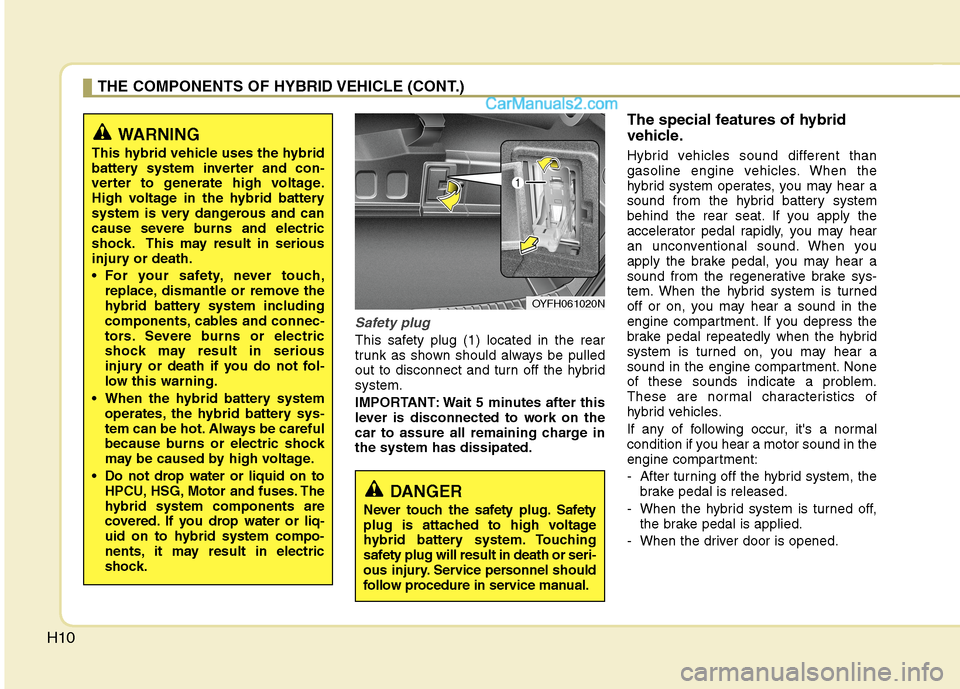
H10
Safety plug
This safety plug (1) located in the rear
trunk as shown should always be pulled
out to disconnect and turn off the hybrid
system.
IMPORTANT: Wait 5 minutes after this
lever is disconnected to work on the
car to assure all remaining charge in
the system has dissipated.
The special features of hybrid
vehicle.
Hybrid vehicles sound different than
gasoline engine vehicles. When the
hybrid system operates, you may hear a
sound from the hybrid battery system
behind the rear seat. If you apply the
accelerator pedal rapidly, you may hear
an unconventional sound. When you
apply the brake pedal, you may hear a
sound from the regenerative brake sys-
tem. When the hybrid system is turned
off or on, you may hear a sound in the
engine compartment. If you depress the
brake pedal repeatedly when the hybrid
system is turned on, you may hear a
sound in the engine compartment. None
of these sounds indicate a problem.
These are normal characteristics of
hybrid vehicles.
If any of following occur, it's a normal
condition if you hear a motor sound in the
engine compartment:
- After turning off the hybrid system, the
brake pedal is released.
- When the hybrid system is turned off,
the brake pedal is applied.
- When the driver door is opened.
THE COMPONENTS OF HYBRID VEHICLE (CONT.)
WARNING
This hybrid vehicle uses the hybrid
battery system inverter and con-
verter to generate high voltage.
High voltage in the hybrid battery
system is very dangerous and can
cause severe burns and electric
shock. This may result in serious
injury or death.
For your safety, never touch,
replace, dismantle or remove the
hybrid battery system including
components, cables and connec-
tors. Severe burns or electric
shock may result in serious
injury or death if you do not fol-
low this warning.
When the hybrid battery system
operates, the hybrid battery sys-
tem can be hot. Always be careful
because burns or electric shock
may be caused by high voltage.
Do not drop water or liquid on to
HPCU, HSG, Motor and fuses. The
hybrid system components are
covered. If you drop water or liq-
uid on to hybrid system compo-
nents, it may result in electric
shock.
DANGER
Never touch the safety plug. Safety
plug is attached to high voltage
hybrid battery system. Touching
safety plug will result in death or seri-
ous injury. Service personnel should
follow procedure in service manual.
OYFH061020N
Page 415 of 425
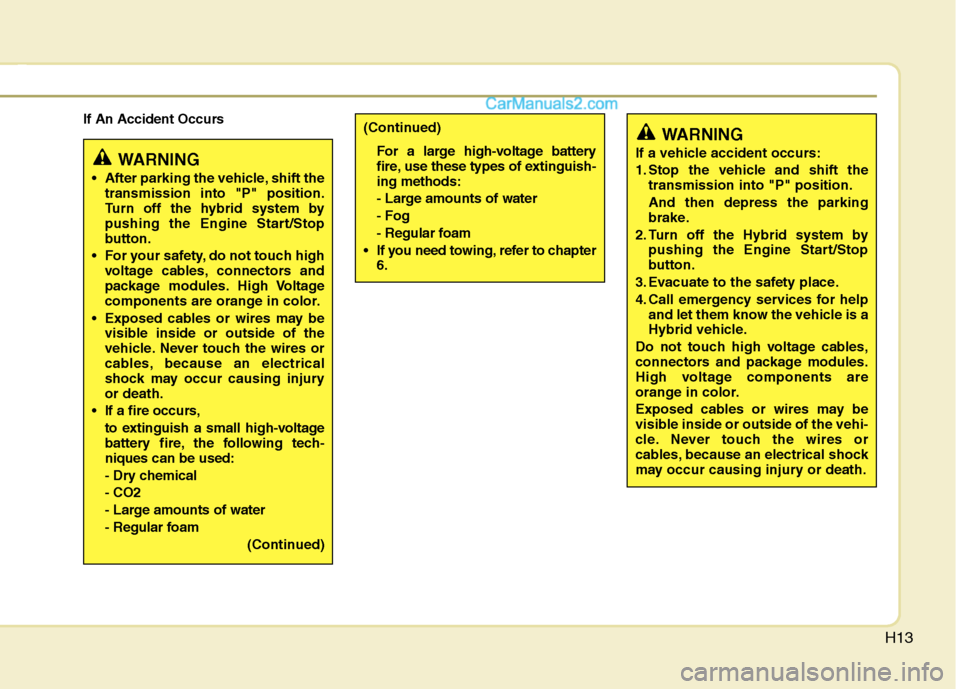
H13
If An Accident Occurs
WARNING
After parking the vehicle, shift the
transmission into "P" position.
Turn off the hybrid system by
pushing the Engine Start/Stop
button.
For your safety, do not touch high
voltage cables, connectors and
package modules. High Voltage
components are orange in color.
Exposed cables or wires may be
visible inside or outside of the
vehicle. Never touch the wires or
cables, because an electrical
shock may occur causing injury
or death.
If a fire occurs,
to extinguish a small high-voltage
battery fire, the following tech-
niques can be used:
- Dry chemical
- CO2
- Large amounts of water
- Regular foam
(Continued)
WARNING
If a vehicle accident occurs:
1. Stop the vehicle and shift the
transmission into "P" position.
And then depress the parking
brake.
2. Turn off the Hybrid system by
pushing the Engine Start/Stop
button.
3. Evacuate to the safety place.
4. Call emergency services for help
and let them know the vehicle is a
Hybrid vehicle.
Do not touch high voltage cables,
connectors and package modules.
High voltage components are
orange in color.
Exposed cables or wires may be
visible inside or outside of the vehi-
cle. Never touch the wires or
cables, because an electrical shock
may occur causing injury or death.
(Continued)
For a large high-voltage battery
fire, use these types of extinguish-
ing methods:
- Large amounts of water
- Fog
- Regular foam
If you need towing, refer to chapter
6.
Page 416 of 425
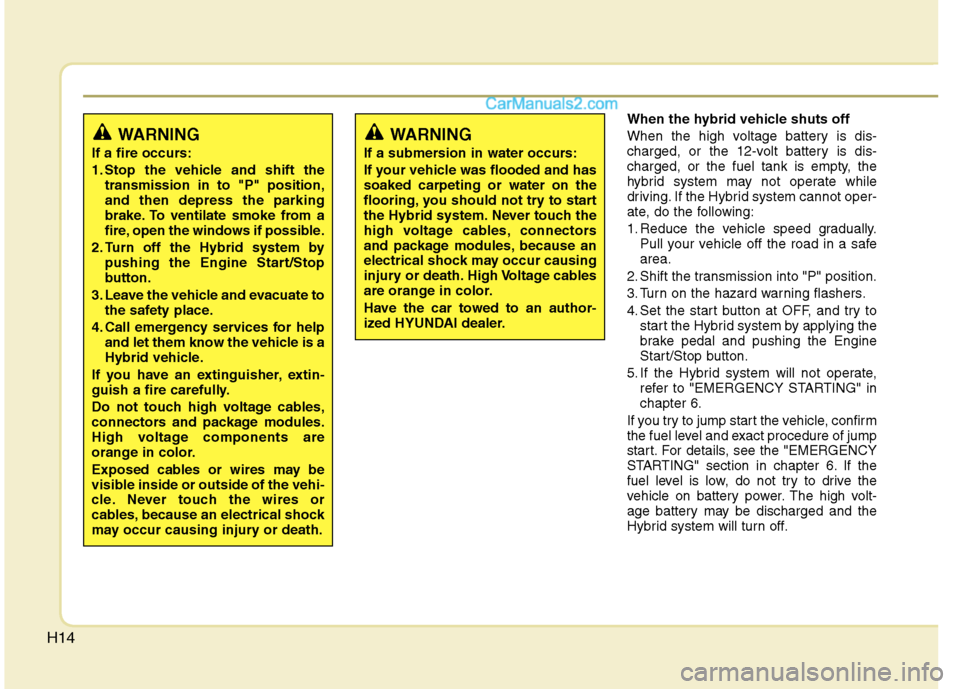
H14
When the hybrid vehicle shuts off
When the high voltage battery is dis-
charged, or the 12-volt battery is dis-
charged, or the fuel tank is empty, the
hybrid system may not operate while
driving. If the Hybrid system cannot oper-
ate, do the following:
1. Reduce the vehicle speed gradually.
Pull your vehicle off the road in a safe
area.
2. Shift the transmission into "P" position.
3. Turn on the hazard warning flashers.
4. Set the start button at OFF, and try to
start the Hybrid system by applying the
brake pedal and pushing the Engine
Start/Stop button.
5. If the Hybrid system will not operate,
refer to "EMERGENCY STARTING" in
chapter 6.
If you try to jump start the vehicle, confirm
the fuel level and exact procedure of jump
start. For details, see the "EMERGENCY
STARTING" section in chapter 6. If the
fuel level is low, do not try to drive the
vehicle on battery power. The high volt-
age battery may be discharged and the
Hybrid system will turn off.
WARNING
If a fire occurs:
1. Stop the vehicle and shift the
transmission in to "P" position,
and then depress the parking
brake. To ventilate smoke from a
fire, open the windows if possible.
2. Turn off the Hybrid system by
pushing the Engine Start/Stop
button.
3. Leave the vehicle and evacuate to
the safety place.
4. Call emergency services for help
and let them know the vehicle is a
Hybrid vehicle.
If you have an extinguisher, extin-
guish a fire carefully.
Do not touch high voltage cables,
connectors and package modules.
High voltage components are
orange in color.
Exposed cables or wires may be
visible inside or outside of the vehi-
cle. Never touch the wires or
cables, because an electrical shock
may occur causing injury or death.
WARNING
If a submersion in water occurs:
If your vehicle was flooded and has
soaked carpeting or water on the
flooring, you should not try to start
the Hybrid system. Never touch the
high voltage cables, connectors
and package modules, because an
electrical shock may occur causing
injury or death. High Voltage cables
are orange in color.
Have the car towed to an author-
ized HYUNDAI dealer.
Page 418 of 425
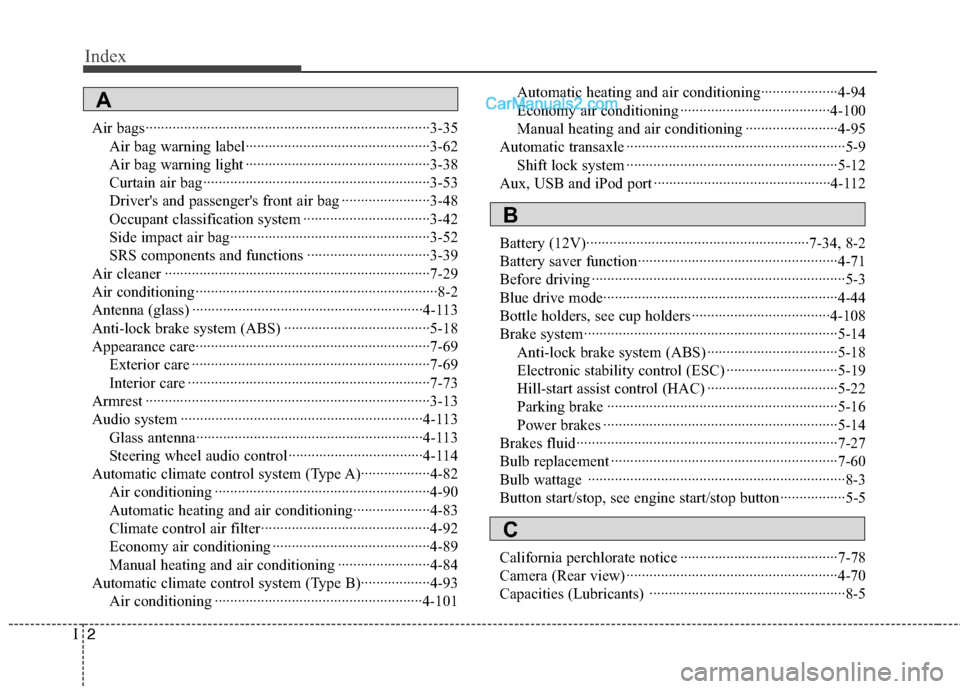
Index
2I
Air bags··········································································3-35
Air bag warning label················································3-62
Air bag warning light ················································3-38
Curtain air bag···························································3-53
Driver's and passenger's front air bag ·······················3-48
Occupant classification system ·································3-42
Side impact air bag····················································3-52
SRS components and functions ································3-39
Air cleaner ·····································································7-29
Air conditioning ·······························································8-2
Antenna (glass) ····························································4-113
Anti-lock brake system (ABS) ······································5-18
Appearance care·····························································7-69
Exterior care ······························································7-69
Interior care ·······························································7-73
Armrest ··········································································3-13
Audio system ·······························································4-113
Glass antenna···························································4-113
Steering wheel audio control···································4-114
Automatic climate control system (Type A)··················4-82
Air conditioning ························································4-90
Automatic heating and air conditioning····················4-83
Climate control air filter············································4-92
Economy air conditioning ·········································4-89
Manual heating and air conditioning ························4-84
Automatic climate control system (Type B)··················4-93
Air conditioning ······················································4-101Automatic heating and air conditioning····················4-94
Economy air conditioning ·······································4-100
Manual heating and air conditioning ························4-95
Automatic transaxle ·························································5-9
Shift lock system ·······················································5-12
Aux, USB and iPod port ··············································4-112
Battery (12V)··························································7-34, 8-2
Battery saver function····················································4-71
Before driving ··································································5-3
Blue drive mode·····························································4-44
Bottle holders, see cup holders ····································4-108
Brake system··································································5-14
Anti-lock brake system (ABS) ··································5-18
Electronic stability control (ESC) ·····························5-19
Hill-start assist control (HAC) ··································5-22
Parking brake ····························································5-16
Power brakes ·····························································5-14
Brakes fluid····································································7-27
Bulb replacement ···························································7-60
Bulb wattage ···································································8-3
Button start/stop, see engine start/stop button·················5-5
California perchlorate notice ·········································7-78
Camera (Rear view) ·······················································4-70
Capacities (Lubricants) ···················································8-5
A
B
C
Page 420 of 425
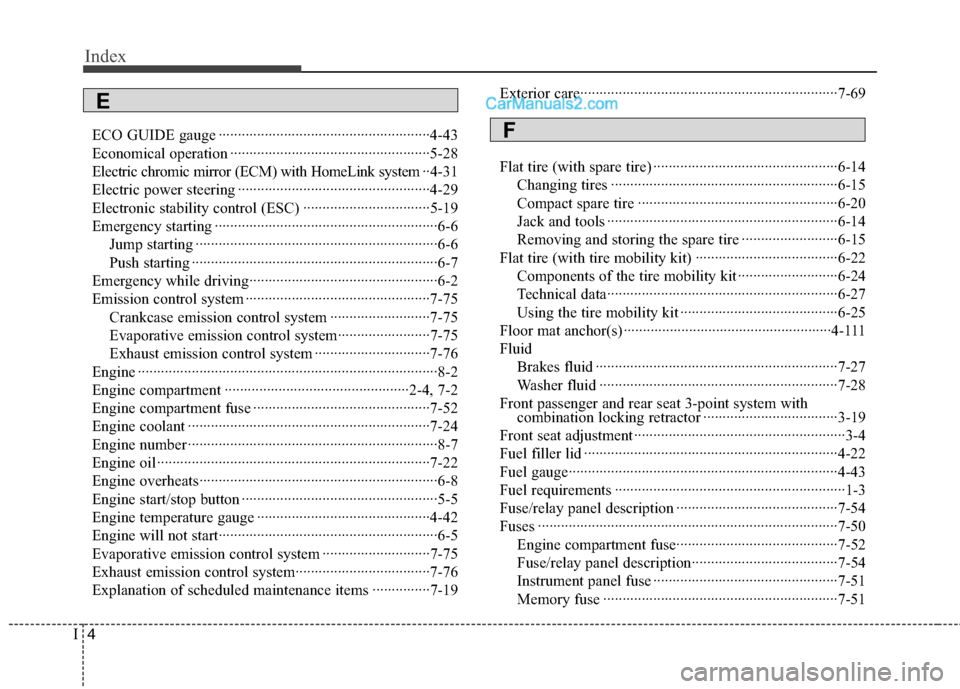
Index
4I
ECO GUIDE gauge ·······················································4-43
Economical operation ····················································5-28
Electric chromic mirror (ECM) with HomeLink system··4-31
Electric power steering ··················································4-29
Electronic stability control (ESC) ·································5-19
Emergency starting ··························································6-6
Jump starting ·······························································6-6
Push starting ································································6-7
Emergency while driving·················································6-2
Emission control system ················································7-75
Crankcase emission control system ··························7-75
Evaporative emission control system························7-75
Exhaust emission control system ······························7-76
Engine ··············································································8-2
Engine compartment ················································2-4, 7-2
Engine compartment fuse ··············································7-52
Engine coolant ·······························································7-24
Engine number ·································································8-7
Engine oil ·······································································7-22
Engine overheats······························································6-8
Engine start/stop button ···················································5-5
Engine temperature gauge ·············································4-42
Engine will not start·························································6-5
Evaporative emission control system ····························7-75
Exhaust emission control system···································7-76
Explanation of scheduled maintenance items ···············7-19Exterior care···································································7-69
Flat tire (with spare tire) ················································6-14
Changing tires ···························································6-15
Compact spare tire ····················································6-20
Jack and tools ····························································6-14
Removing and storing the spare tire ·························6-15
Flat tire (with tire mobility kit) ·····································6-22
Components of the tire mobility kit ··························6-24
Technical data····························································6-27
Using the tire mobility kit ·········································6-25
Floor mat anchor(s) ······················································4-111
Fluid
Brakes fluid ·······························································7-27
Washer fluid ······························································7-28
Front passenger and rear seat 3-point system with
combination locking retractor ···································3-19
Front seat adjustment ·······················································3-4
Fuel filler lid ··································································4-22
Fuel gauge······································································4-43
Fuel requirements ····························································1-3
Fuse/relay panel description ··········································7-54
Fuses ··············································································7-50
Engine compartment fuse··········································7-52
Fuse/relay panel description······································7-54
Instrument panel fuse ················································7-51
Memory fuse ·····························································7-51
E
F
Page 423 of 425

I7
Index
Occupant classification system······································3-42
Odometer ·······································································4-41
Oil (Engine) ···································································7-22
Outside rearview mirror·················································4-38
Overheats ·········································································6-8
Owner maintenance ·························································7-5
Panorama sunroof ··························································4-25
Parking brake ·································································5-16
Parking brake inspect·····················································7-28
Passenger's front air bag ················································3-48
Power brakes··································································5-14
Power outlet ·································································4-110
Power window lock button ············································4-20
Pre-tensioner seat belt····················································3-21
Push starting·····································································6-7
Rear seat·········································································3-11
Rear view camera ··························································4-70
Recommended cold tire inflation pressures ··················7-37
Recommended lubricants and capacities ·························8-5
Recommended SAE viscosity number························8-6Refrigerant label ······························································8-8
Replacement light bulb ··················································7-60
Reporting safety defects ················································8-10
Road warning ···································································6-2
Rocking the vehicle ·······················································5-30
Scheduled maintenance service ·······································7-7
Maintenance under severe usage conditions ·············7-18
Normal maintenance schedule ····································7-8
Seat belt warning ···························································3-16
Seat belts ········································································3-15
Driver's 3-point system with emergency locking
retractor ···································································3-17
Front passenger and rear seat 3-point system with
combination locking retractor ·································3-19
Height adjustment ·····················································3-18
Pre-tensioner seat belt ···············································3-21
Seat belt warning·······················································3-16
Seat belts height adjustment ··········································3-18
Seat warmer ····························································3-9, 3-12
Seatback pocket ·····························································3-10
Seats ·················································································3-2
Armrest ······································································3-13
Front seat adjustment ··················································3-4
Headrest ·····························································3-7, 3-11
Rear seat ····································································3-11
Seat warmer ·······················································3-9, 3-12
P
R
S
O